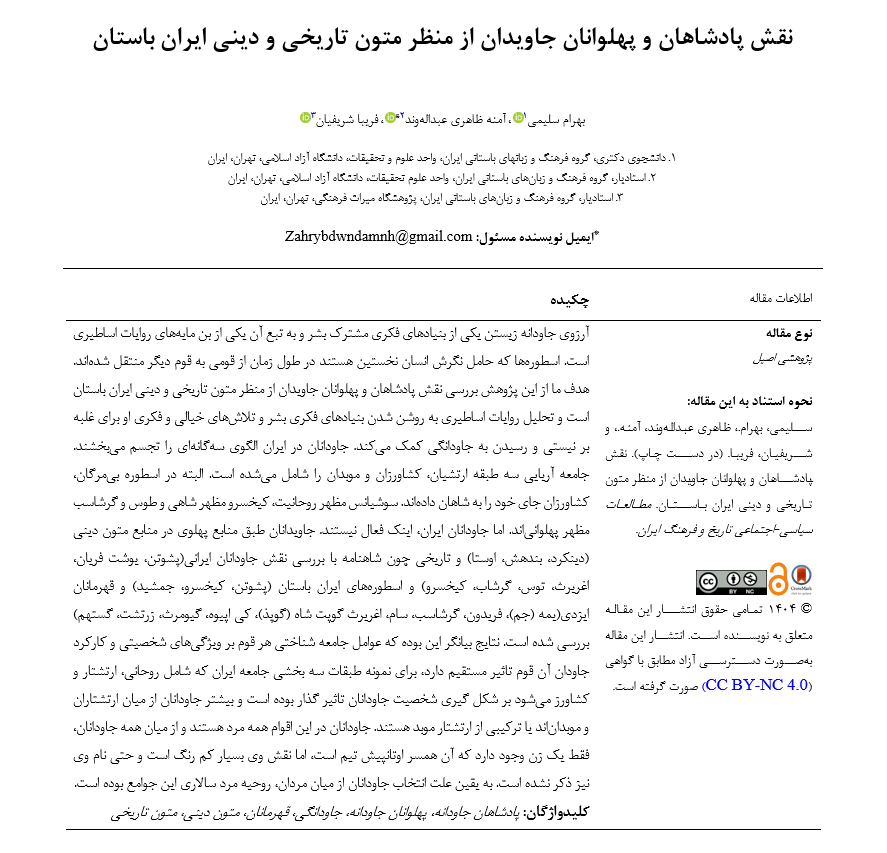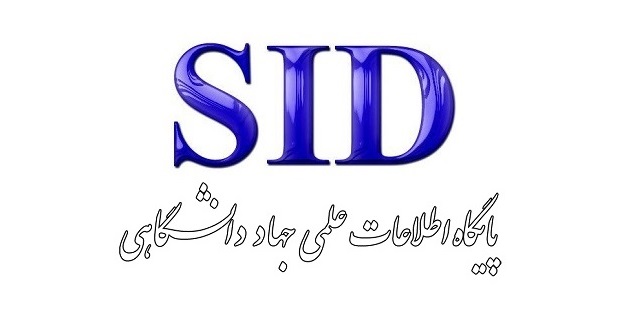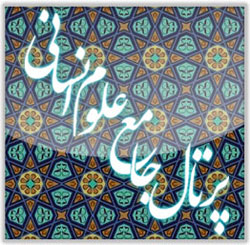نقش پادشاهان و پهلوانان جاویدان از منظر متون تاریخی و دینی ایران باستان
کلمات کلیدی:
پادشاهان جاودانه, پهلوانان جاودانه, متون تاریخی, جاودانگی, قهرمانان, متون دینیچکیده
آرزوی جاودانه زیستن یکی از بنیادهای فکری مشترک بشر و به تبع آن یکی از بن مایههای روایات اساطیری است. اسطورهها که حامل نگرش انسان نخستین هستند در طول زمان از قومی به قوم دیگر منتقل شدهاند. هدف ما از این پژوهش بررسی نقش پادشاهان و پهلوانان جاویدان از منظر متون تاریخی و دینی ایران باستان است و تحلیل روایات اساطیری به روشن شدن بنیادهای فکری بشر و تلاشهای خیالی و فکری او برای غلبه بر نیستی و رسیدن به جاودانگی کمک میکند. جاودانان در ایران الگوی سهگانهای را تجسم میبخشند. جامعه آریایی سه طبقه ارتشیان، کشاورزان و موبدان را شامل میشده است. البته در اسطوره بیمرگان، کشاورزان جای خود را به شاهان دادهاند. سوشیانس مظهر روحانیت، کیخسرو مظهر شاهی و طوس و گرشاسب مظهر پهلوانیاند. اما جاودانان ایران، اینک فعال نیستند. جاویدانان طبق منابع پهلوی در منابع متون دینی (دینکرد، بندهش، اوستا) و تاریخی چون شاهنامه با بررسی نقش جاودانان ایرانی(پشوتن، یوشت فریان، اغریرث، توس، گرشاب، کیخسرو) و اسطورههای ایران باستان (پشوتن، کیخسرو، جمشید) و قهرمانان ایزدی(یمه (جم)، فریدون، گرشاسب، سام، اغریرث گوپت شاه (گوپذ)، کی اپیوه، گیومرث، زرتشت، گستهم) بررسی شده است. نتایج بیانگر این بوده که عوامل جامعه شناختی هر قوم بر ویژگیهای شخصیتی و کارکرد جاودان آن قوم تاثیر مستقیم دارد، برای نمونه طبقات سه بخشی جامعه ایران که شامل روحانی، ارتشتار و کشاورز میشود بر شکل گیری شخصیت جاودانان تاثیر گذار بوده است و بیشتر جاودانان از میان ارتشتاران و موبداناند یا ترکیبی از ارتشتار موبد هستند. جاودانان در این اقوام همه مرد هستند و از میان همه جاودانان، فقط یک زن وجود دارد که آن همسر اوتانپیش تیم است، اما نقش وی بسیار کم رنگ است و حتی نام وی نیز ذکر نشده است. به یقین علت انتخاب جاودانان از میان مردان، روحیه مرد سالاری این جوامع بوده است.
دانلودها
مراجع
Afifi, R. (1995). Myths and culture of Iran in Pahlavi writings. Tehran: Tous Publishing.
Amouzgar, J. (2007). Mythical history of Iran. Tehran: Organization for the Study and Compilation of Humanities Books (Samt).
Amouzgar, J., & Tafazzoli, A. (2001). The myth of the life of Zoroaster. Tehran: Cheshmeh Publishing.
Amouzgar, J., & Tafazzoli, A. (2007). Book five of the Dinkard. Tehran: Mo'in Publishing.
Azar Farangbagh, P. F., & Azar Bad, P. O. (2002). Book three of the Dinkard (F. Fazilat, Trans. ed.). Tehran: Dehkhoda Cultural Publishing.
Behzadi, R. (1989). Bandehush Hindi. Tehran: Cultural Studies and Research.
Christensen, A. (2008). The Kayanids (Z. Safa, Trans. ed.). Tehran: Scientific and Cultural Publishing.
Fatehi, A. (2004). Gushtasp in the Avesta and Shahnameh. Kayhan Cultural Magazine, 211(5), 57-69.
Ferdowsi, A. Q. (1998). Shahnameh. Tehran: Sooreh Publishing.
Fotouhi Kohsareh, M. (2016). A discussion on the cause of Peshotan's immortality in the Zoroastrian tradition. Journal of Epic Literature Research, 95(22), 456-475.
Ghorbani, G. (2021). The relationship between immortality and belief in the afterlife with the meaning of human life. Scientific Quarterly of Metaphysical Research, 2(4), 106-133.
Haj Nourouzi, N., Hasani Jalilian, M. R., & Hosseini, S. M. (2020). O life of lovers in death: Manifestation of elements of the myth of immortality and the remedy for death in mystical prose texts. Islamic Mysticism Scientific Quarterly, 77(20), 125-139.
Kalantari, I. (2008). Immortality in world literature. Message of Archaeologist, 5(9), 72-85.
Mansouri, M., & Gholami, H. (2016). A study of some themes creating the desire for immortality with a mythological approach. Journal of Mystical Literature and Mythology, 43(12), 125-136.
Mir Fakhraei, M. (2006). An analysis of the sixth Dinkard. Tehran: Human Sciences Research Institute Publishing.
Molaei, C. (2013). An analysis of the Farvardin Yasht. Tabriz: University of Tabriz Publishing.
Namiraniyan, K. (2003). Mythological foundations of the birth of Zoroaster. Book Monthly of Art, 55(56), 142-159.
Nazari Farsani, M. (2018). Book eight of the Dinkard. Tehran: Faravahar Publishing Organization.
Pashtdar, A. M. (2021). Commentary and interpretation of the Shahnameh of Ferdowsi. Alborz: Jihad University Press, Alborz Unit (Khorasani).
Rashid Mohasel, M. T. (2010). Book seven of the Dinkard. Tehran: Human Sciences Research Institute Publishing.
Razi, H. (2001). Avesta (the oldest written treasure of ancient Iran). Tehran: Bahjat Publishing.
Samsar Khiyabaniyan, F., & Pashayi Fakhri, K. (2022). A comparative study of immortality in the mythological worlds of Sepehri and Albayati. Scientific Quarterly of Comparative Literature, 16(16), 53-70.

دانلود
چاپ شده
ارسال
بازنگری
پذیرش
شماره
نوع مقاله
مجوز
حق نشر 2025 Bahram Salimi (Author); Ameneh Zaheri Abdolhavand (Corresponding Author); Fariba Sharifian (Author)

این پروژه تحت مجوز بین المللی Creative Commons Attribution-NonCommercial 4.0 می باشد.







